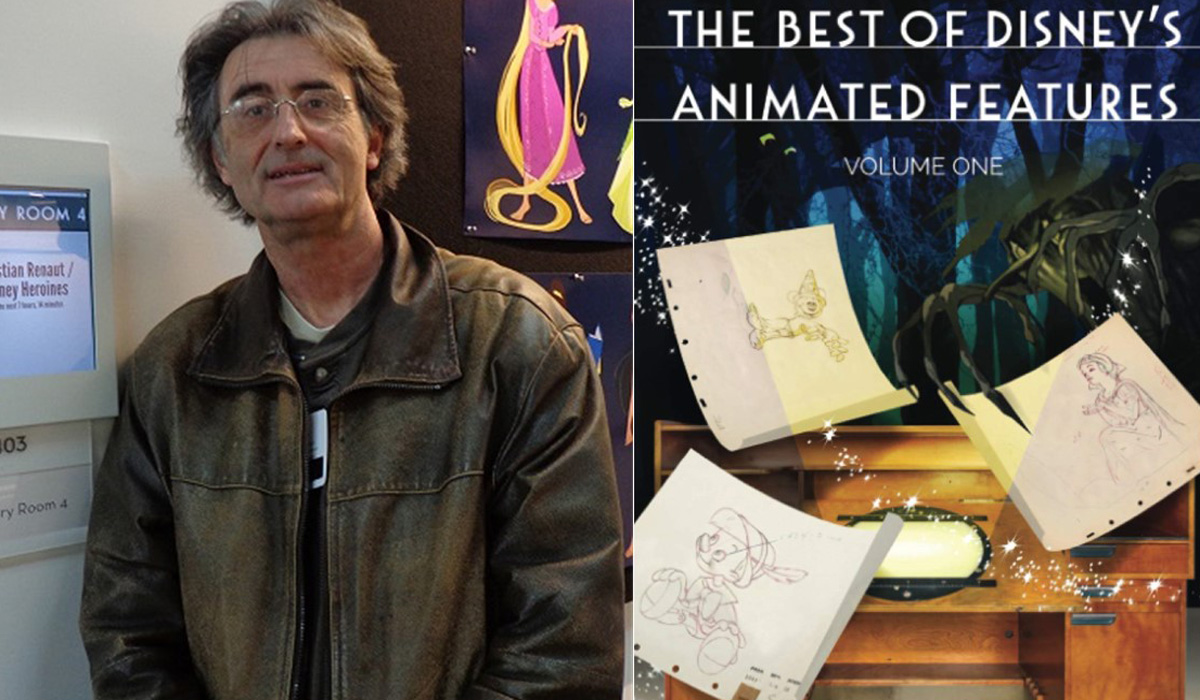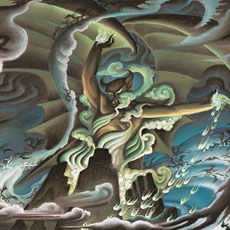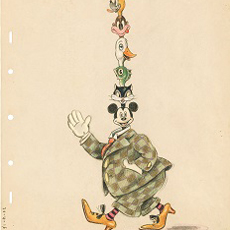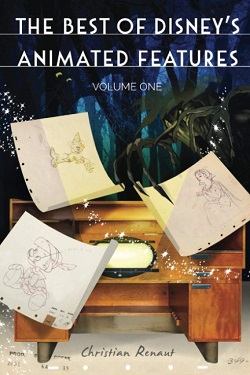 A ‘Best of’ book on Disney’s animated features? How biased! How ridiculous! How impossible! This may well be a first reaction.
A ‘Best of’ book on Disney’s animated features? How biased! How ridiculous! How impossible! This may well be a first reaction.
Yet, after launching a poll about ten years ago in Europe and the USA, French author Christian Renaut could eventually come up with a list, because some sequences do stand out. They stand out for various reasons, based on sentimental memories as well as artistic criteria.
Out of that poll came this book, The Best Of Disney’s Animated Features, just published (in English) by Theme Park Press, whose aim is to dive into the making of those memorable sequences.
Renaut is well-known for his first book, From Snow White To Hercules, published by Dreamland in 1997, with a foreword written by Ollie Johnston and Frank Thomas. The congratulations he received from Roy Disney and Michael Eisner opened even more doors for another project, The Disney Heroines, published in 2000, with a foreword by Glen Keane. He was also one of the main authors of the booklets for the Walt Disney – Figurines de collection series by Hachette, published in France, Belgium and Canada.
Now, thanks to in-depth research, hundreds of personal exclusive interviews of artists from several generations, the help of renowned experts, and several visits to the Walt Disney Archives, the first volume of this new venture is now completed.
We asked Christian to tell us more about this volume and his exciting journey up its publication.
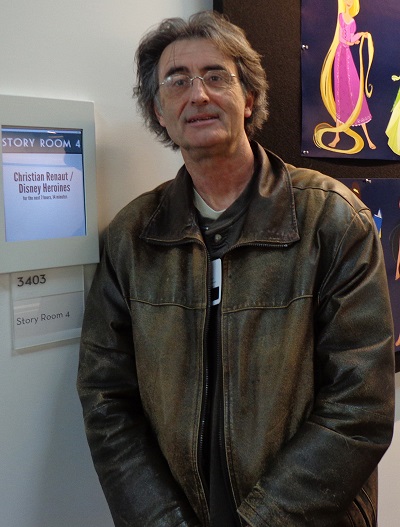
Animated Views: Where does your interest in Disney’s animated features come from?
Christian Renaut: I believe that like you and all Disney buffs, I was mesmerized by one of the first features I saw when I was probably 5 or 6. I can’t tell which one it was, could be a Lady And The Tramp reissue. I am sure I saw Mary Poppins on its first original release. Then started a real passion, along with collecting memorabilia. But unlike some others, I have always been more interested in animated features. I also like live-action ones, the parks, (and) the shorts, but to a lesser extent. So, it is not because the Disney stamp is on something that I necessarily fall for it. I’m not at all into the Star Wars and Marvel universes. And I am a die-hard defender of hand-drawn animation.
AV: How did your project start out?
CR: Well, when Dreamland closed down in the early 2000’s, I had already planned other books with Thierry Steff. Suddenly, it was all called into question, so I kind of gave up. But then, I realized on the Internet that people talked a lot about my two books, although two (books) is really not much. I decided to resume researches for a book that would focus on the animated features, but in another way, because so many books do. Meanwhile, Didier Ghez asked me to contribute interviews to launch his great Walt’s People series. So, I thought about dealing with great ‘classics’ in terms of sequences more particularly, the moments that you always remember for whatever reason.
AV: How would you explain the concept of your book and how did you come to it?
CR: The point is above all to decipher and analyze the making of a selected list of those sequences for each feature. So, I launched a poll in 2009, with the help of Didier Ghez, and I received answers from various countries. They came from historians, Disney artists, sons and daughters of those artists, former Disney artists, and fans. This was very interesting, because many justified their choices, and you soon came to realize that everyone has their own reasons. Still, a list clearly appeared. I have to indicate that at the time, I only planned one book with a list of 20 sequences from only the films that Walt had supervised. Then came the time to look for a publisher, but the market had changed a lot, and more importantly, it was clear that a handful of historians were privileged by Disney to write books. In short, as long as I intended to write an illustrated book, many editors refused to indulge in a costly and risky adventure, under Disney’s scrutiny. Finally, I went for a book that would be text only, and my editor Theme Park Press, with the tireless Bob Mc Lain, gave me complete freedom and also agreed on a series of volumes instead of one book. He also asked that I prolonged beyond The Jungle Book.
AV: What aspects of the classics do you treat?
CR: It may sound pretentious, but I try to deal with everything: the original sources (like fairy tales), the adaptation/story work, preliminary artwork, layout and backgrounds, all the steps of animation, special effects, inking, painting, and of course music and songs. I try to trace back the artistic influences, not through hypotheses, though it may happen, but through interviews and researches. It is strange to notice that very few books deal with story for instance, besides Paper Dreams by the incomparable John Canemaker. The same applies to special effects and more. Secondly, however brilliant and amazing the Nine Old Men were, I thought that other people deserved praise too among the animators. When I interviewed artists, I could feel frustrations, and it is true that we know next to nothing about people like Cliff Nordberg or Hal King, and so many others, although they played a big part.
As to the word “sequence”, it is a global term. In most cases, they do correspond with entire sequences as defined by the script. Some other times, it is just one short segment of a whole sequence like in ‘The Nutcracker Suite’ in Fantasia. Although it is far from being my favorite moment, many had put the Mushroom passage forward. Some other times, for consistency, I decided to combine two into one like for Pinocchio, with the bird’s eye view shot discovery of the village and schoolboys in the morning, and then the street part with Foulfellow and Gideon.
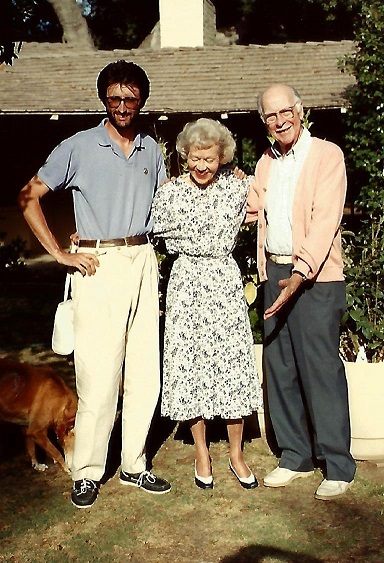
AV: What makes your approach original? Considering how vivid Disney historical research has been for the past decades, many books have been written on the first classics, such as Snow White, Pinocchio and Fantasia. How did you find “your” way into that amount of literature?
CR: I can’t compare myself with such historians as J.B Kaufman (who helped me). Such books are top-notch and beyond compare. We also have to know that these historians have an easier access to the Disney Archives these days than I have. When I started out in the late 1980s, I had a pass to freely stay there almost as long as I wanted! As I explain in my introduction, it was a time of transition between the so-called Morgue and the Animation Research Library. It means that I was brought whole boxes with heaps of pastels and sketches by Bodrero, Blair, Da Gradi, and other legends. You could touch them on your own, can you believe that? Today is a very different story…
What is different with my book is the fact I analyze sequences only. J.B does that in his books for the whole features, though, but he can’t write as many pages as I can for lack of room with the pictures. Secondly, as aforesaid, my focus is on unsung artists and departments. Thirdly, my speech is completely free of any restraints by the powers-that-be. Lastly, I tried to bring a European or French approach to my analysis, referring a lot to which artists inspired the Disney Studio, and also drawing information and interviews from French, British, Belgian, Italian or Spanish sources. It is particularly true as regards layout and architecture.
To finish with, when I think of it, my books might well be criticized, and you have to accept that, but there is one thing I can’t be reproached with, and it is my determination to be honest. There was a time in the 1970s when the very few books written about either Walt or the Studio were so polished you could hardly believe it. Walt was a saint and the Studio was Heaven. Walt himself often repeated he was no saint. In the 1990s on the contrary, some bitter resentful writers decided to turn Walt into Satan and the Studio into Hell. They resorted to laid off artists, frustrated ones, to draw quick conclusions that responded to their wishes with mountains of bad faith. Neither is satisfactory. Sure, you can feel in autobiographies by Bill Peet, Jack Kinney or Herb Ryman how angry they became. Thank God, recently, the books written by serious and reliable historians have reached a much better balance. Though my book is not about Walt, he only appears as a human being, just an incredibly creative human being, and the Studio appears as a workplace, with fallouts, euphoria, doubts and challenges.

AV: Your research is based on an incredible number of interviews, certain ones dating back to the 1980s. Can you tell me about those first ones? In what context did you do them?
CR: The first time I went to Burbank was in 1987. It took forever to get the pass to get in, but I finally could. Most of my first interviews I got through Frank Thomas and Ollie Johnston, or through the indispensable Howard Green. Many veterans were still alive then. When I say ‘interviews,” it includes historians, but I also interviewed some artists several times like Frank Thomas, Burnie Mattinson or Andreas Deja four times. Needless to say, it was emotional to meet all of them, and so was it for them, because some had never returned to the Studio lot, which is where I did most of my interviews. I also often went to their homes, where I was always warmly welcomed, having several dinners with Ollie, spending a whole evening with Ken O’Connor, or lunch with Marc Davis or a whole morning with Ward Kimball. The latter had very reluctantly accepted another interview and was so fed up with them he had told me: “A half hour, no more.” I stayed three hours! What I liked is that I could interview people who had never or scarcely been interviewed: Ken O’Brien, Dale Oliver, Walt Stanchfield, and many more. Disney artists know them very well though. I also was one of the lucky few to interview (by letter) Bill Peet himself, though at the time he had retreated and refused all interviews. I had him on the phone too, though. However, Mike Barrier (who helped me, too) and John Canemaker have an impressive list of interviewed people and there are many I wished I had met.
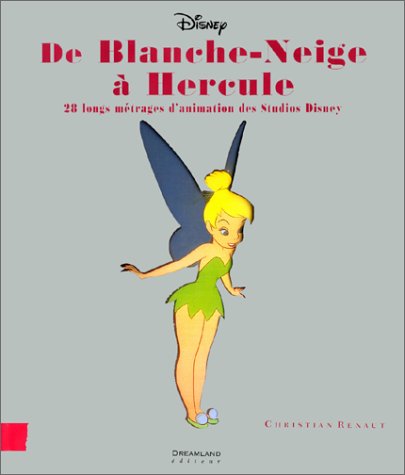
AV: We mentioned From Snow White To Hercules, your first success. What memories do you keep from that time?
CR: Thanks for the word ‘success.’ Although it took 14 years of ups and downs to have it published, I feel like a spoilt child. Once I got the publishing contract from Thierry Steff and Xavier Pezet of Dreamland, it was Dreamland indeed. Whatever image I wanted, even whole animation scenes of my choice, whatever the text, I didn’t have to change a single word, even after the Disney people in Paris read it. It was the same with my Disney Heroines book. I cherish that time.
AV: How did you come to update your work from the 1980s? What new interviews did you get? How difficult is it to collect memories and information about classics from so long ago?
CR: In 1998, I returned to Los Angeles for the second book, and could meet people I had never met before, including Joe Grant, Ilene Woods, or Vance Gerry and many of the newer generation. All through those years, I have kept interviewing people, either live or now by mail. Of course, the Internet enables you to contact way more people. Moreover, Didier Ghez has always been very helpful. So, I interviewed old acquaintances again, but alas many are dead now. Besides, I started to interview the sons and daughters of say Woolie Reitherman, Joe Grant, Hal King etc…All serious historians know that we should always use interviews with a pinch of salt. Memories of old timers may falter, some may toot their own horns, some would rather conceal some aspects, some others bear grudges. However, it is fascinating, as you well know yourself. One thing I regret, I lost the tape of my interview with Phil Dike!
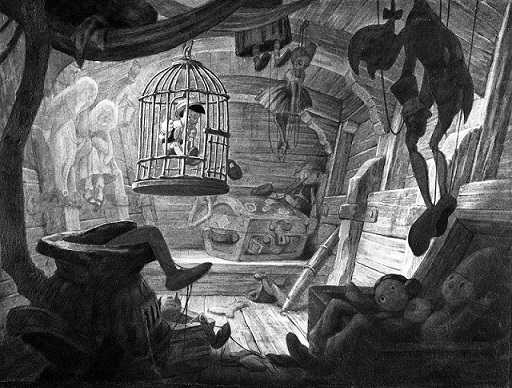
AV: What were your most memorable encounters as far as interviewees are concerned?
CR: Whoa, this could make a whole book in itself! As to encounters, there are so many. Undoubtedly, spending a whole day around my region driving Ollie and Marie Johnston will remain forever in my memory. Ollie kept talking about Walt, the Studio, as we were sightseeing. The first ever meeting had taken place in Paris where I was on cloud nine meeting Frank and Ollie. There was also a famous Sunday when Ollie invited me at his home in La Canada, saying he would ride his train for me. I casually came to have lunch with them, when suddenly I saw Andy Gaskill, Paula Sigman Lowery (Disney Archives), Glen Keane and many more come with their families. Ollie had planned it all so I could meet them and guess what? As everybody was leaving, and so was I, at around 5 pm, Ollie tells me: “Why don’t you stay for dinner?” I politely refused, and as he insisted, I saw that Glen Keane and his wife (with little Claire) would stay too. So, I spent the whole dinner watching those two legends discussing animation. I could also spend two hours with Glen in Paris going through many of his animations. I have so many more, like recently seeing Walt’s reconstituted office, or the legendary wing at Burbank to see Milt Kahl’s office. I absolutely want to pay a tribute to Philippe Videcoq, whom I thank in all of my books. He was Disney press secretary when I met him in 1977 and he opened all the doors for me, nothing would have been possible without him. Over in California, Howard Green was always a sweet guy who organized most interviews for me.
AV: Without divulging too much of the content of the book, what kind of interesting and unheard-of information did you manage to uncover?
CR: Most books on Disney animation dwell a lot on the first features, and then, fewer and fewer pages are dedicated to later films. This won’t be the case with all the volumes. I’m currently working on a Cinderella sequence, and I have a wealth of information and interviews. As a result, so much has been said by excellent pundits that it is hard to find new gems. Luckily, David Johnston has written an unpublished book (which is a MUST) about Snow White. He posted two chapters on the Internet, and all the rest is kept secret. But he let me have access to it all, and it is a treasure. Some of his interviews were published by Theme Park Press, and they are first class. With his approval, I could deliver some new information. For Pinocchio, it was harder as J.B Kaufman’s book is so complete, but you will find some new things. As to Fantasia, John Culhane’s book is okay, but he apparently could not write a bigger book. So, there’s more to say.
The reader should know that my speech is absolutely free. Make no mistake, my point has never been to lambast Disney, as some very biased disgruntled writers may have done. But it doesn’t mean that all was well in Mickey’s Studio. The polished image that was carefully crafted for years is a far cry from reality. There were rivalries, hurt egos, politics, jealousies, bitterness and disillusions. Even if my point is certainly not to dwell on tensions, you will see that some artists disagreed a lot, and there were real inside artistic fights, for instance on the look of Snow White or ‘The Mushroom Dance’ in Fantasia. Artists are sensitive people, and generally have egos, so it is all natural that there were tensions. Milt Kahl often said that Walt’s first merit was to have maintained this group of artists together for so long. And he knew what he was talking about. However, this is not the bulk of the book; but through interviews, I think we get a clearer idea of what a struggle it sometimes was, for Walt included, to achieve their goals.
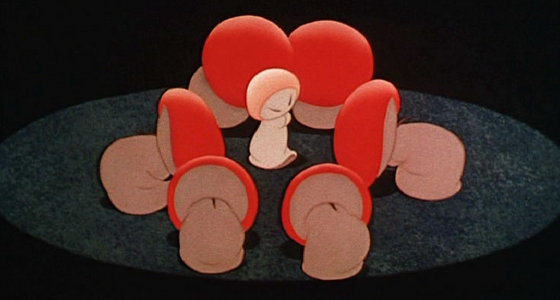
AV: How helpful was the community of Disney historians?
CR: Extremely helpful. I can’t give the list of all the historians who have helped me, but I must cite Didier Ghez, who helped me out with the poll and more. I would never imagine that such luminaries as John Canemaker or J.B Kaufmann would take time to help me. There are also people like Mindy Johnson, Hans Perk, but again, there are so many, the list is in the book. Brian Sibley had already been very generous with my previous endeavors. And of course, I can’t forget the late Robin Allan. I could have access to all his Archives when I went to Exeter University. He was the sweetest man and volume one is dedicated to him. Regarding music, Ross Care and yourself sure have been great helps.
AV: Can you tell me about the role of your editor in that project?
CR: It was all a breeze to work with Bob McLain. He trusts you completely. He didn’t take out a single word, so I could find the same liberty I had enjoyed years ago. A concern was my writing in English, I’m no native. I was afraid it would not be good enough, but he reassured me and corrected the text if needed. I was particularly happy that he suggested writing more volumes, so it is going to be a long story!
AV: The title of your book indicates it’s the first volume. What can we expect for the future?
CR: If everything goes as planned, there should be a volume every year. I am currently at work on Volume 2 (from 1942 to 1950). When I am done with the films under Walt, I will launch a second poll for a list of films from 1967 on. But that shouldn’t be before years (from now). Each volume will be prefaced by a different artist or a historian. I have already been lucky with prefaces by Frank and Ollie, Glen Keane, and this time Andreas Deja for my books.
My expectations are that readers feel they are inside the Studio and realize the amount of work that was done. Hopefully, they will learn a few things more. And I also hope there won’t be too many mistakes. I do my best with the accesses I have, but there might be some errors here and there I apologize for. I write books out of passion, this is not my job, but it sure is fun!
Christian Renaut’s The Best Of Disney’s Animated Features: Volume One is available to order from Amazon.com!



